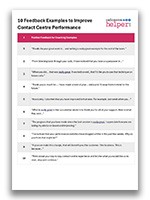In any high-performing contact centre, regular feedback isn’t just a routine – it’s a powerful tool for driving improvement, building confidence, and boosting morale.
But giving feedback doesn’t have to feel like a critique session. When approached thoughtfully, it can become one of your most effective coaching strategies.
In this article, we share real-world examples of positive feedback you can use right away, along with proven coaching models and key rules to ensure your feedback is both constructive and empowering.
Examples of Positive Feedback For Effective Coaching
Giving constructive feedback to call centre agents during coaching sessions doesn’t have to be a negative experience.
We have put together 10 positive coaching feedback examples for you to use now:
1. “Thanks For Your Great Work In… And Setting A Really Great Example For The Rest Of The Team.”
Colleagues will listen to one another. They will talk about work and, ideally, they will be sharing best practices to improve customer experience.
Telling advisors that their work is a great example to others may encourage them to go on and share their tips with the rest of the team and spread high performance.
2. “From Listening Back Through Your Calls, I Have Noticed That You Have A Superpower In…”
Strength-spotting is a key part of giving good feedback. If you only give critical feedback, employees will start to approach coaching sessions with an overarching sense of dread.
By bolstering an advisor’s belief in a personal strength, you will give them a sense of pride in what they do. This is often a key ingredient in good customer service.
If you do not like to say: “You have a superpower,” say: “You’re very good at…”
Another similar good feedback example is: “One thing that I really admire about how you interact with customers is…”
3. “When You Did… That Was Really Great. It Worked So Well, That I’d Like You To Use That Technique On Future Calls.”
Define the actions that you would like to turn into habits. Give the advisor the confidence to replicate that behaviour through giving this positive feedback.
It is then good to spread the action across the whole contact centre, using call/screen recordings, to praise publicly and spread best practice.
4. “Thank You So Much For… I Have Made A Note Of Your… Skills And I’ll Keep Them In Mind For The Future.”
When an employee does something especially noteworthy, show recognition and encourage them to replicate that behaviour by hinting that it will have a good bearing on their future.
Career progression opportunities can be very motivating and using them as a tool to spur on advisors can work well in terms of improving performance.
For a list career progression opportunities that you can offer your team, read our article: 10 Career Progression Opportunities to Offer Your Team
5. “Absolutely. I Also Feel That You Have Improved In That Area. For Example, Last Week When You…”
When giving positive feedback, get advisors talking for themselves, in terms of where they are improving, and then back them up. Reinforce the positive behaviour.
You can do this by being specific, highlighting an example of where you have recognized that performance improvement too. This recognition is important in terms of encouraging future improvement.
6. “What Is Really Great Is That A Customer Wrote In To Thank You For All Of Your Support. Here Is What They Said…”
When looking to motivate your team through giving good feedback, it can be nice to share a positive message from a customer who has really appreciated the job that the advisor did.
Not only will this help team members to feel a closer connection with customers, but this technique can be a good way of creating a customer-focused culture.
7. “The Progress That You Have Made Since The Last Session Is Really Great. I Appreciate How You Are Taking My Advice On Board And Improving.”
Track to see whether advisors are following through on the performance objectives that you worked together to create in previous one-to-one sessions.
If you see improvement, give them good feedback and show your gratitude that the employee is taking your advice on board. This may motivate them to continue improving.
8. “I’ve Noticed That Your Performance Statistics Have Dropped A Little In The Past Few Weeks. Why Do You Think That Might Be?”
Giving constructive feedback can be tricky. Of course, from time to time, it needs to be given, but you must safeguard the advisor’s thoughts and feelings, to avoid demotivating them further.
One good technique is to use the question above, so the employee has the chance to come up with their own ideas to improve. This better engages them with their performance and increases the likelihood that they will buy in to improvement opportunities.
9. “If You Can Make This Change, That Will Benefit You /The Customer / The Business. This Is Because…”
By giving the employee feedback along these lines, you can motivate them with a future sense of opportunity to make things better for themselves, the customer or the business.
If you ask a team member to do something, and they don’t understand why you are asking them to do it, their determination to improve their performance will be weaker.
10. “Think About Your Day-To-Day Contact Centre Experience And Tell Me What You Would Like Us To Start, Stop And Continue.”
Improving performance is not all about giving good feedback to an employee. You should always be open to making improvements too.
To improve, also look for good, constructive feedback from your team. A good technique for this is to ask advisors what can I start, stop and continue?
Printable – 10 Positive Coaching Feedback Examples
Do you want to download this to use with your team?
Get your free download of 10 Positive Coaching Feedback Examples now:
Key Rules for Giving Good Feedback
These good feedback examples work best when delivered positively and effectively.
To get your feedback delivery right, Sean Spurgin – Learning Director of Elev-8 Performance – recommends sticking to the following guidelines:
- Intent – The intent is good and the desire is to help the other person.
- Supportive – Delivered in a non-threatening, encouraging manner.
- Direct – The focus of the feedback is clearly stated.
- Sensitive – Delivered to the other person with sensitivity to their needs.
- Considerate – Not intended to insult or demean.
- Descriptive – Focused on behaviour, not personality.
- Specific – Focused on a specific event or behaviour.
- Timing – Delivered as close to the prompting event as possible
- Thoughtful – Well considered rather than impulsive.
- Helpful – Intended to be of value to the other person.
- Personal – Speak for yourself, not others, and say what you mean.
- Permission – Given with the consent of the other person.
Coaching Feedback Models
Many leaders like to use a model to better structure their employee feedback. Here are seven such examples that you can use with your employees.
The Feedback Sandwich
The premise of this model is to start and end on a positive note, so that you begin the conversation on a positive note and leave the employee happy at the end.
Sandwiched between these two bits of positive feedback is where you bring up key areas for improvement, so that they are easier to “digest”.
It’s a simple technique that has a lot of merit. Just be careful that you don’t overuse it. Otherwise it can become predictable and the team will only start to focus on the negative.
For more on this, watch the video below where Kim Ellis, Chief Learning Architect at Go Ginger Learning Solutions, explains how to use the Sandwich Technique in customer service when providing feedback to both agents and customers.
The 3:1 Ratio (3 Positive to 1 Negative)
Another simple feedback model is to give three bits of good feedback to every one constructive piece of feedback.
By doing so, you highlight lots of key achievements, while setting up an area for potential improvement, once the employee has settled into the conversation.
Again, this can be an overly simple solution, so, if you decide to use this feedback model, do try to use it alongside a mixture of other techniques.
Why and How
This model is great to use when giving constructive feedback. It works by showing the employee why they need to make the change, before highlighting how they can do so.
While simple, it’s important that the employee feels invested in making the change early, so they are more interested in learning how they can then transform their performance.
It’s all about giving the employee a purpose and a motivation to improve. That is a key part of giving good feedback.
The Continue and Begin Model
This model was devised by contact centre expert Nick Drake-Knight.
Like “The Feedback Sandwich“, this technique starts by helping the employee to feel good. To do this, the leader asks the employee: “What would you like to continue to do well?” This helps the employee to reflect upon their success.
Next, ask the employee: “What would you like to begin to do, in order to do an even better job of meeting performance standards?” This can lead to some really great coaching conversations.
Such a model allows advisors to think about their performance gaps themselves, so you are not seen to be “prescribing” solutions. If they come up with solutions themselves, they’ll buy into them better.
The ERIC Model
This model is not just for giving employees feedback, it can also help to gather it.
ERIC is an acronym for:
- Eliminate
- Reduce
- Increase
- Create
Take your team through this model and first ask them: “To make your life easier, what can we eliminate/reduce/increase/create?”
Be receptive to all of their feedback and set the standard by following each rule of the 14 below for receiving feedback.
Then turn the tables, so both parties can take away key pieces of feedback to improve performance.
Situation, Behaviour, Impact
When you have an urgent piece of feedback to give to an employee, outside of your regular one-to-one sessions, this might just be the model to use.
As the name suggests, the model works in three stages:
- Explaining the situation.
- Highlighting the specific behaviour that you’d like to address.
- Describing the impact this behaviour has had on you, colleagues and the wider business.
This technique is one to use when giving good, critical, constructive feedback, as it can be really useful in helping leaders manage difficult scenarios.
With this structure you can highlight just how impactful certain behaviours are, while confronting the situation in a professional manner.
The Five-Word Performance Review
Created by Paul English, the CEO of Kayak.com, this feedback model works by simply giving advisors five words to describe their work.
Not only is this simple and friendly, but it gives the feedback session a positive, friendly feel – so employees don’t enter feedback conversations with an overarching sense of dread.
The employee then has five key takeaways, while the leader can then discuss each word in more detail to get their full point across.
Key Rules for Receiving Feedback
Working in the contact centre is not all about giving feedback, you should also be actively looking for feedback to improve performance further.
When receiving feedback, you want to set an example to the rest of the team, which can really bolster the value of coaching conversations.
With this in mind, Sean shares a few of his golden rules for taking good feedback on board.
- Be Grateful – Remember, it’s just as difficult to give feedback as it is to receive it.
- Ask for Feedback – Let your team know that you would appreciate their feedback and advice.
- Share Your Preferences – Get feedback when it’s most useful by asking for it when you need it.
- Don’t Be Defensive – Don’t argue with the feedback giver. Take the feedback under advisement and ask yourself if it’s truthful.
- Be Circumspect – Don’t focus on the part of the feedback that makes no sense right now.
- Act on It – There is nothing more frustrating than repeatedly offering the same advice.
- Listen – Keep an open mind. See feedback as an opportunity to improve, rather than a personal attack.
- Ask Questions – Discuss suggestions and ask for examples to help you understand what’s meant.
- Volunteer Your Own Suggestion – Talk about areas where you feel you could improve.
- Talk About Strengths and Development Areas – The point is to find areas where you can grow.
- Remove Judgement – Don’t use “what” questions. Start sentences with “how”.
- Be Constructive and Specific – Take control and ask for examples that demonstrate what the feedback means.
- Feedback Is Integral to Learning – Remind yourself of that on a regular basis.
- You Don’t Have to Accept Feedback – But you do owe it to yourself to think about it and evaluate it.
For more on giving good feedback, read our articles:
- How to Give Feedback to an Employee… Without Upsetting Them
- How to Achieve Excellent Customer Service Through Coaching
- 10 Ways to Improve Call Centre Performance Management
Author: Charlie Mitchell
Reviewed by: Megan Jones
Published On: 12th May 2021 - Last modified: 2nd Oct 2025
Read more about - Customer Service Strategy, Agent Performance, Charlie Mitchell, Employee Feedback, Free Downloads, Kim Ellis, Nick Drake-Knight, Performance Management, Sean Spurgin, Service Strategy




















